12 Jan 2021
Nicola Menzies-Gow looks at some of the topic areas covered at the 4th Global Equine Endocrine Symposium in January 2020.

At the start of the year, the 4th Global Equine Endocrine Symposium was held in Germany, hosted by Boehringer Ingelheim. Specialists and researchers from around the world shared their recent research on a broad range of topics relevant to equine endocrinology.
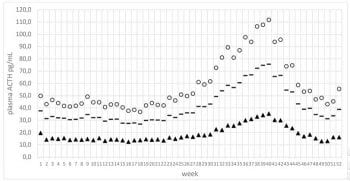
The proceedings from the symposium can be found on the Equine Endocrinology Group website (http://sites.tufts.edu/equineendogroup/), and it contains the abstracts for all of the studies discussed.
A cross-sectional study of horses with pituitary pars intermedia dysfunction (PPID) in the UK, facilitated by owner completion of a questionnaire, was undertaken to gather information on the demographics, management and health care of horses with PPID1.
The survey revealed that the median age of the study population was 23 years, the median duration of ownership was 12 years, half of the animals were geldings and half were ponies. Nearly all horses received turnout, but most owners restricted access to grass, most commonly through the use of strip grazing – and those with a history of laminitis were turned out for less time.
The majority of animals received daily forage and a fibre-based feed, and approximately half of the population received some form of daily exercise, which was most commonly low-intensity hacking and more common in younger animals. More than half of the horses were reported to have at least one concurrent health condition – most commonly OA and equine metabolic syndrome (EMS).
Within a cohort of animals enrolled in an epidemiological study of equine laminitis in the UK2, 28% were tested for PPID, of which 47% were positive. Of those animals with PPID, 70% were receiving pergolide therapy. The odds of PPID increased with age, and was greater in Arabs and lower in cobs. Laminitis and EMS were common comorbidities in animals with PPID.
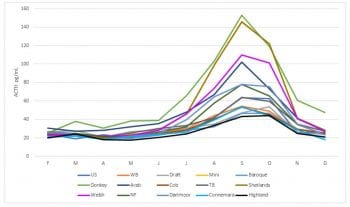
The overall prevalence of EMS within a cohort of native ponies and cobs in the UK was 23%3. Risk factors for EMS included increasing age, Welsh section A breed, a less active principal use for the animal, reduced time at grass in summer and being overweight.
Regarding clinical manifestations, animals with EMS were more likely to have had one or more episode of laminitis in the past five years, divergent hoof growth rings and supraorbital fat accumulation.
Within a cohort of animals enrolled in an epidemiological study of equine laminitis in the UK, the overall prevalence of EMS was 9%4. The odds of EMS were higher in Arabs and native breeds, and in animals aged 10 to 19 years old. Animals with EMS were more likely to have a cresty neck and a history of laminitis, and their owners were more likely to employ weight management strategies.
Pregnenolone is a potent neurosteroid that could potentially contribute to the lethargy reported in some animals with PPID. Therefore, the steroid hormone concentrations in the peripheral blood were compared between horses with PPID and healthy horses5.
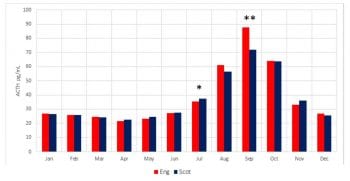
The study found that cortisol and pregnenolone concentrations were actually lower in animals with PPID, but the concentrations of five other steroid hormones were increased. The reasons for these differences were unclear, and warrant further investigation.
Equine insulin dysregulation (ID) is associated with increased glucose bioavailability, but the mechanism underlying this is unclear. Incretins are hormones secreted by enteroendocrine cells in the small intestines in response to dietary nutrients. Glucagon-like peptide-2 (GLP-2) is an incretin that increases glucose uptake from the intestine, and plasma GLP-2 concentrations are higher in ponies with ID. In vitro studies demonstrated that the equine jejunum secretes GLP-2, secretion increases in response to glucose stimulation and secretion is inhibited when the sodium-glucose co-transporter 1 glucose transporters are inhibited6. Therefore, the incretin GLP-2 may be responsible for the increased glucose bioavailability in equine ID.
Horses with hyperinsulinaemia have an increased number of pancreatic islets, which may help explain the persistent hyperinsulinaemic response and the absence of pancreatic exhaustion that occurs in humans with type 2 diabetes7.
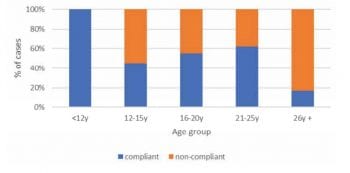
Magnesium metabolism plays an important role in human diabetes mellitus; patients often have low serum magnesium concentrations and magnesium supplementation may have a beneficial effect on insulin sensitivity. Compared to healthy control, intracellular magnesium concentrations were lower in horses with ID8. The effect of magnesium supplementation in these animals requires further investigation.
Oxidative damage to the hypothalamus is integral to the development of PPID, but mechanisms leading to this oxidative damage are unclear. Both obesity and ID are associated with oxidative stress in other species; therefore, markers of oxidative stress were measured in healthy Welsh ponies and Quarter horses, and were found to be higher in Welsh ponies, and positively correlated with insulin concentration and girth circumference in ponies, but not horses9.
As a result, the impact of increased reactive oxygen metabolites on the hypothalamus – and, therefore, the risk of PPID development in ponies with ID – warrants further investigation.
Several studies relevant to the use of basal adrenocorticotropic hormone (ACTH) concentrations to diagnose PPID were presented. The first was a systematic review and meta-analysis of previously published studies focusing on the diagnostic accuracy of basal ACTH concentrations for the diagnosis of PPID10.
The results from 10 studies were included in meta-analysis; the overall sensitivity was 68% and the specificity was 86%, supporting the current recommendation that basal ACTH concentrations should be used as an initial diagnostic test and that further ones should be performed in cases that test negative.
A second study used laboratory submissions across a six-year period to derive temporally specific diagnostic thresholds for equine plasma ACTH concentrations. These were applicable throughout the year and to different clinical scenarios, depending on whether a false positive or a false negative result would be deemed least desirable11.
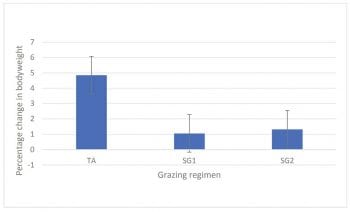
Therefore, this study introduced the concept of the diagnostic threshold varying according to the degree of clinical suspicion of the disease and according to whether it was more important to be confident the result was truly positive or truly negative.
Further studies reported breed differences in basal plasma ACTH concentrations in healthy animals, and these differences were most marked in autumn, to the point that breed-appropriate seasonally adjusted reference ranges might be required12,13.
Basal ACTH concentrations were significantly affected by transportation for 40 minutes, but unaffected by dental examination, meaning diagnostic samples should not be collected immediately after transportation14. The autumn peak in basal ACTH concentrations was lower in samples from animals in Scotland compared to southern England, and, therefore, latitude should be taken into consideration when diagnosing PPID15.
Freeze-thaw cycles affect plasma ACTH concentrations and so should be avoided when measuring ACTH16. ACTH is not stable even in samples kept frozen at -80°C and so samples should not be stored long term17.
Liquid chromatography mass spectrometry was used to demonstrate that the PPID hormone corticotrophin-like intermediate peptide (CLIP) binds to the capture antibody used in the chemiluminescence assay, supporting the hypothesis that CLIP cross-reactivity affects measured ACTH concentrations18.
Epidemiological information was obtained from a large number of horses showing one or more clinical sign(s) suggestive of PPID. The association between each variable and PPID status, based on basal ACTH concentrations, was used to develop a clinical sign score (CSS)19. The higher the CSS, the more likely an animal was to have PPID. Therefore, the CSS may be useful for veterinarians to decide whether measurement of basal ACTH concentration is necessary in an individual animal. If only one out of potbelly/weight gain, excessive thirst, regional adiposity or recurrent infections is present, then evaluation of ACTH for PPID is not recommended.
The repeatability of the thyrotropin-releasing hormone (TRH) stimulation test was evaluated in horses with and without PPID, and found to be limited when two tests were performed six days apart20. However, in contrast, a second study investigated the repeatability of the test at four-week intervals over a five-month period and found the test produced repeatable ACTH concentrations in samples collected 10 minutes after administration of TRH21.
The effect of TRH dose on the ACTH response was evaluated in two studies22,23, and both found that 0.5mg and 1.0mg TRH produced similar ACTH responses, and had better sensitivity and specificity than 0.25mg.
Many veterinarians will freeze doses of TRH and then thaw them prior to visiting the horse at its home stables. If the TRH is not used for some reason, it is not known whether the TRH remains stable if it is subsequently kept refrigerated prior to use in another animal.
One study investigated the effect of one freeze-thaw cycle and subsequent storage at 5°C over time, and found the TRH produced repeatable ACTH concentrations after storage of the TRH for up to 56 days24.
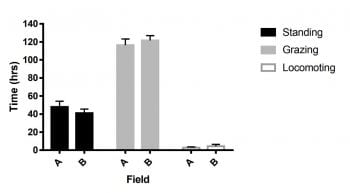
TRH stimulation tests are recommended in animals with equivocal basal ACTH concentrations. The basal ACTH concentrations and ACTH concentration following TRH stimulation were compared in 438 horses, and a poor correlation was noted between the two25. Therefore, performing a TRH stimulation test frequently alters clinical decision-making supporting use of the test.
A clinical audit of the management of PPID in a single veterinary practice revealed only 87% of cases were initially treated as per the current guidelines (pergolide 2μg/kg once a day), only 78% were monitored, and of those being monitored only 48% had a follow-up test within the first one to three months26. Therefore, the management of cases fell below the current evidence-based clinical guidelines and required improvement.
The effect of pergolide dosing compliance on the laboratory control of PPID was investigated using the clinical records from two first opinion equine veterinary practices in the UK27.
Overall, only 48% of cases were compliant, that is, receiving the dose of pergolide recommended by the attending veterinarian. However, no significant effect of compliance on the laboratory control of PPID was noted, that is, return of plasma ACTH concentrations to within the seasonally adjusted reference range.
Compliance was worst in the oldest animals (25 years or older) and in Shetlands. Laboratory control was similarly worst in Shetlands and best in animals aged 12 to 15 years old.
A questionnaire was used to gather data on owner-perceived rating of quality of life in animals with PPID28. Overall, horses with PPID appear to enjoy a good quality of life and pergolide therapy was positively correlated with quality of life.
The owners of 25 horses on long-term pergolide therapy completed a survey about their experience with this treatment 10 years after starting therapy29. Owner satisfaction with treatment was high, with all owners agreeing that pergolide improved quality of life and prolonged lifespan.
The improvement in clinical signs was greatest for lethargy, haircoat and muscle mass. The majority of owners agreed they would treat another horse with pergolide long term, but medication cost would be a factor to consider.
The effect of three restricted grazing practices used for equine bodyweight management were compared. Strip grazing using either just a lead fence or a lead and a back fence resulted in significantly lower gains in bodyweight compared to being allowed access to the total herbage allowance30. Therefore, strip grazing appears to be a useful tool in restricting weight gain at pasture.
The effect of strip grazing on physical activity was assessed31. Strip grazing did not have a negative effect on the amount of time ponies spent undertaking physical activity. So, the beneficial effect of reducing calorie intake through the geographic restriction of pasture access should not be offset by a reduction in calorie expenditure.
Animals with PPID and ID did not respond as well to management with a diet and exercise regime tailored to the individual animal compared to those with ID alone32.
Straw has poor digestibility, and a high-fibre and low-water soluble carbohydrate content, resulting in a reduction in calorie intake. The longer ingestion time and poor palatability also reduces daily dry matter intake. Feeding a 50:50 mixture of hay and straw for four months resulted in greater weight loss compared to feeding hay alone in native ponies kept at pasture over winter33.
Although hyperinsulinaemia is known to play a crucial role in the induction of endocrinopathic laminitis, the mechanism of insulin action is unclear because insulin receptors are scarce in the lamellar tissue. Lamellar stretching and cellular proliferation are key histologic feature of endocrinopathic laminitis. In vitro studies have demonstrated that insulin can stimulate proliferation of lamellar cells by activating insulin-like growth factor 1 (IGF-1) receptors and that this effect can be blocked using a selective anti-IGF-1 receptor antibody34. Therefore, the IGF-1 receptor is a potential therapeutic target for treating or preventing endocrinopathic laminitis.
A new modified Obel grading system was designed for use in a research setting, but has now also been validated for use in the clinical setting35. It is a 12-point scale based on weight shifting, foot lifting, gait at the walk, gait on a circle and the digital pulse.